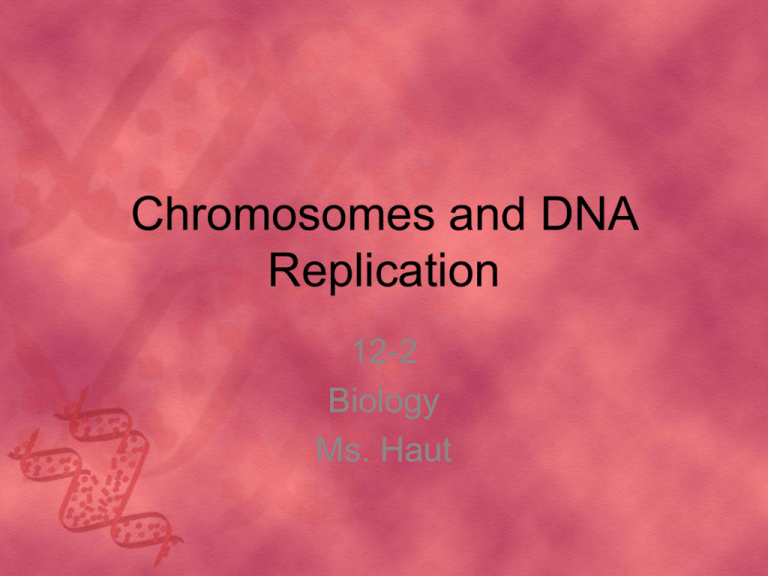
Chromosomes and DNA
Replication
12-2
Biology
Ms. Haut
DNA and Chromosomes
• DNA and Chromosomes
• In prokaryotic cells, DNA is located in the
cytoplasm.
• Most prokaryotes have a single DNA molecule
containing nearly all of the cell’s genetic
information.
Copyright Pearson Prentice Hall
DNA and Chromosomes
• Many eukaryotes have 1000 times the
amount of DNA as prokaryotes.
• Eukaryotic DNA is located in the cell
nucleus inside chromosomes.
• The number of chromosomes varies
widely from one species to the next.
Copyright Pearson Prentice Hall
Dog Karyotype
Humans have:
44 autosomes
2 sex chromosomes
46 total
Pig Karyotype
http://www.humangenetik.uni-bremen.de/Karyotyp%20Hund.gif
http://www.animalgenome.org/edu/gene/pigkar.gif
DNA and Chromosomes
• Chromosome Structure
Copyright Pearson Prentice Hall
– Eukaryotic
chromosomes contain
DNA and protein,
chromatin.
– DNA tightly coils around
proteins called
histones.
– DNA and histones form
nucleosomes.
– Nucleosomes pack
together, forming a thick
fiber.
DNA Replication
• Each strand of the DNA double helix has
all the information needed to reconstruct
the other half by the mechanism of base
pairing.
• What is the complementary strand for the
following DNA sequence?
TA C G G AT T G AA G
AT G C C TAA C T T C
Copyright Pearson Prentice Hall
• In most prokaryotes,
DNA replication
begins at a single
point and continues in
two directions.
Copyright Pearson Prentice Hall
http://www.studentsguide.in/microbiology/true-bacteria-eubacteria/images/the-replicatio-of-abatcerial-chromosomes.jpg
http://en.wikivisual.com/images/0/00/Binary_fission.png
DNA Replication
DNA Replication
• In eukaryotic
chromosomes, DNA
replication occurs at
hundreds of places
(origins of replication).
• Replication proceeds in
both directions until each
chromosome is
completely copied.
• Speeds up the time it
takes to copy the DNA.
From Essential Biology with Physiology, 2 ed. By Campbell, Reece.
Copyright Pearson Prentice Hall
DNA Replication
• Duplicating DNA
– Before a cell divides, it duplicates its DNA in a
process called replication.
– Replication ensures that each resulting cell
will have a complete set of DNA.
Copyright Pearson Prentice Hall
DNA Replication
• DNA molecule
separates into two
strands
• Two new
complementary
strands following the
rules of base pairing
are made.
• Each strand of the
double helix of DNA
serves as a template
for the new strand.
Copyright Pearson Prentice Hall
http://images.suite101.com/230204_trans98.jpg
DNA Replication
•DNA replication depends on specific base pairing
– DNA replication
• Starts with the separation of DNA strands
– Then enzymes use each strand as a template
• To assemble new nucleotides into
complementary strands
A
T
A
T
A
T
A
T
A
T
C
G
C
G
C
G
C
G
C
G
G
C
G
C
G
C
G
C
T
A
T
A
T
A
T
A
T
A
A
T
A
T
A
T
Parental molecule
of DNA
C
A
Nucleotides
Both parental strands serve
as templates
Two identical daughter
molecules of DNA
DNA Replication
• DNA replication is carried out by DNA
helicase that “unzips” the molecule of DNA.
• Hydrogen bonds between base pairs are
broken and the two strands of DNA unwind.
DNA
helicase
Copyright Pearson Prentice Hall
DNA Replication
• DNA polymerase joins complementary
nucleotides to produce a DNA molecule
and then “proofreads” each new DNA
strand.
Copyright Pearson Prentice Hall
DNA Replication
In prokaryotic cells, DNA is found in the
a)
b)
c)
d)
cytoplasm.
nucleus.
ribosome.
cell membrane.
Copyright Pearson Prentice Hall
The first step in DNA replication is
a)
b)
c)
d)
producing two new strands.
separating the strands.
producing DNA polymerase.
correctly pairing bases.
What enzyme separates the 2 strands of DNA?
DNA helicase
How does helicase separate the strands?
by breaking the hydrogen bonds
Copyright Pearson Prentice Hall
A DNA molecule separates, and the sequence
GCGAATTCG occurs in one strand. What is
the base sequence on the other strand?
a)
b)
c)
d)
GCGAATTCG
CGCTTAAGC
TATCCGGAT
GATGGCCAG
Copyright Pearson Prentice Hall
In addition to carrying out the replication of
DNA, the enzyme DNA polymerase also
functions to
a) unzip the DNA molecule.
b) regulate the time copying occurs in the cell cycle.
c) “proofread” the new copies to minimize the
number of mistakes.
d) wrap the new strands onto histone proteins.
Copyright Pearson Prentice Hall
The structure that may play a role in regulating
how genes are “read” to make a protein is the
a)
b)
c)
d)
coil.
histone.
nucleosome.
chromatin.
Copyright Pearson Prentice Hall







